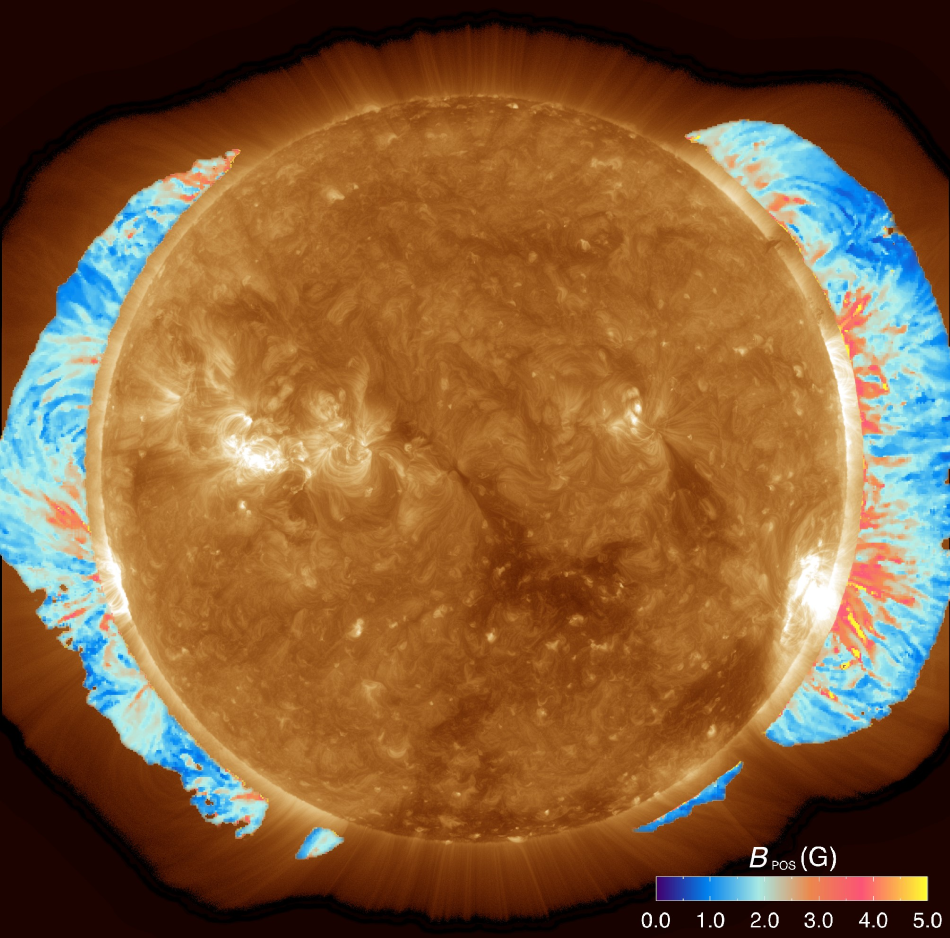Aug 6 2020
An international team of solar physicists, including academics from Northumbria University, Newcastle, has recently measured the global magnetic field of the outer most layer of the Sun’s atmosphere, the solar corona, for the first time.
 A map of the coronal magnetic field strength superimposed on a coronal image taken by the AIA instrument on the Solar Dynamics Observatory (Yang et al. 2020, Science).
A map of the coronal magnetic field strength superimposed on a coronal image taken by the AIA instrument on the Solar Dynamics Observatory (Yang et al. 2020, Science).
The team, including researchers from Peking University, China and National Center for Atmospheric Research (NCAR), USA, used observations from the Coronal Multi-channel Polarimeter (CoMP), an instrument that can provide measurements of infrared radiation coming from the Sun’s atmosphere. Their research has just been published in the journal Science.
The Sun is a magnetized star, and its magnetic field plays a critical role in shaping the solar atmosphere. The magnetic field governs many aspects of the Sun’s behaviour, leading to an 11-year solar cycle, spectacular solar eruptions, and the heating of the hot gas (plasma) in the solar corona to millions of degrees Celsius.
The magnetic field threads through the different layers of the Sun’s atmosphere, which means that information on the magnetic field of the whole atmosphere is required in order to understand the interplay between the solar plasma and magnetic field.
However, up until now, routine measurements of the solar magnetic field have only been achieved at the surface of our star (the area of the Sun known as the photosphere).
While more than 100 years has passed since the first measurement of the Sun’s magnetic field, we still do not have a precise knowledge of the magnetic field in the upper solar atmosphere, especially the corona.
More than 20 years ago, a technique called magnetoseismology was put forward as a way to measure the magnetic field in the corona. This method makes use of magnetic waves, known as Alfvén waves, that are observed to travel along the magnetic fields.
Importantly, the speed the waves travel at depends on the strength of the magnetic field, meaning that being able to measure how fast they travel enables an estimate of the magnetic field to made.
Dr Richard Morton, a UKRI Future Leader Fellow working at Northumbria University, is a world expert in the observation and analysis of waves in the Sun’s corona and was part of the team which delivered these exciting results.
Dr Morton has been a long-term user of the CoMP instrument and advocate of using such measurements to study the Sun’s magnetic field. As he explains: “The data that is collected from CoMP reveals the Sun’s corona is full of these Alfvén waves and provides us with the best available view of them.”
The current research is built upon Dr Morton’s earlier works, which demonstrated the possibility the magnetic waves could be used as a tool (Morton et al., Nature Communications 2015, Long et al., Astronomy & Astrophysics, 2017).
“I think that this is a wonderful demonstration of how we can exploit the Alfvén waves to probe the properties of the Sun,” Dr Morton added, noting that, “the process is similar to how seismologists use earthquakes to find out what the interior of the Earth looks like.”
This is the first time that a global map of the coronal magnetic field has been obtained through actual coronal observations, thus marking a leap towards solving the problem of coronal magnetic field measurements.
In principle, with this technique, global coronal magnetic field maps could now be routinely obtained, filling in the missing part of the measurements of the Sun’s global magnetism. Together with simultaneously measured magnetic field measurements from the Sun’s surface, these synoptic coronal magnetograms will provide critical information to advance the understanding of how the magnetic field couples the different layers of the Sun’s atmosphere as well as the physical mechanisms responsible for solar eruptions and solar cycle.
The research has been published in the journal Science (Yang et al. Science 2020).
Find out more about the work of Dr Morton and Northumbria University’s Solar Physics research group.